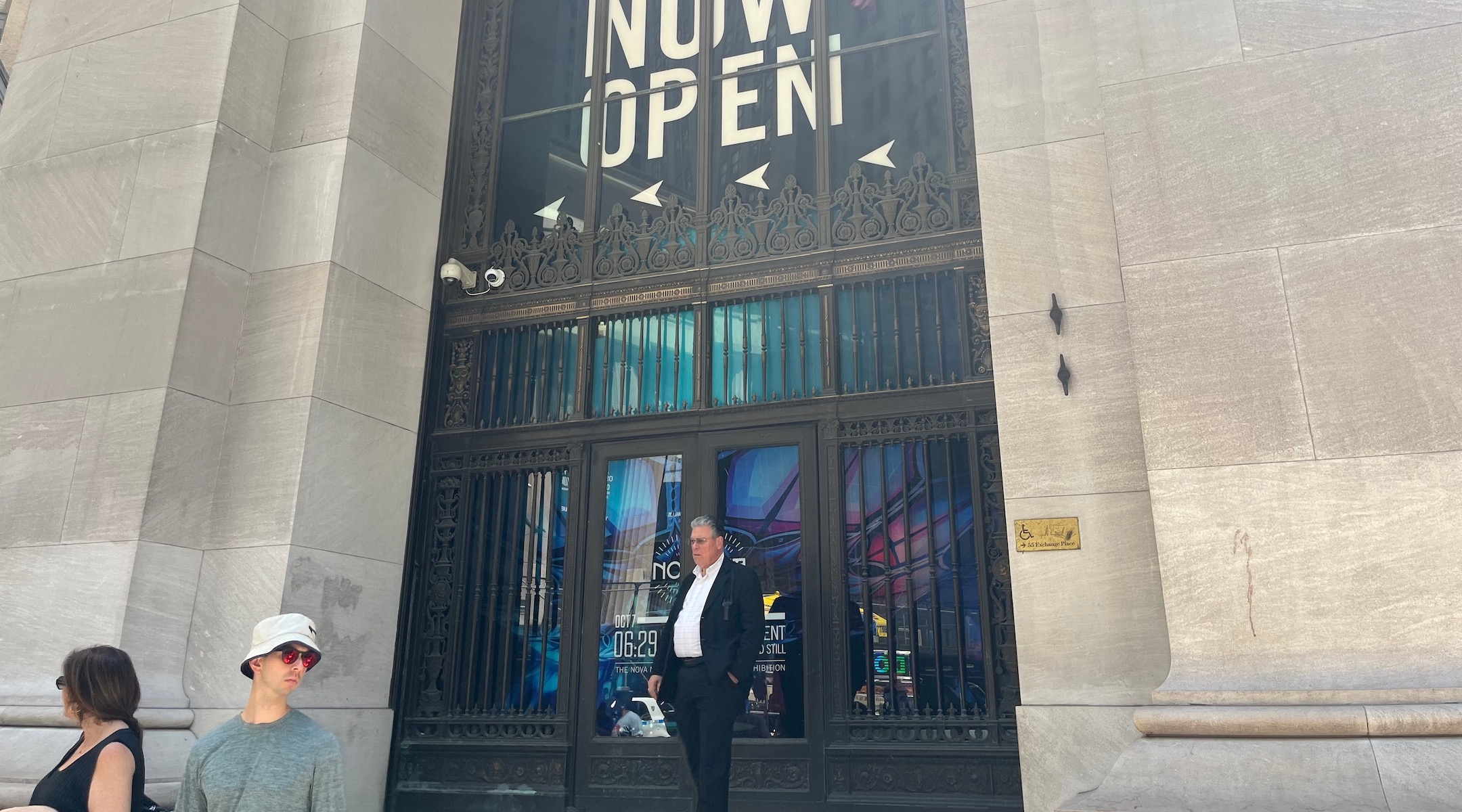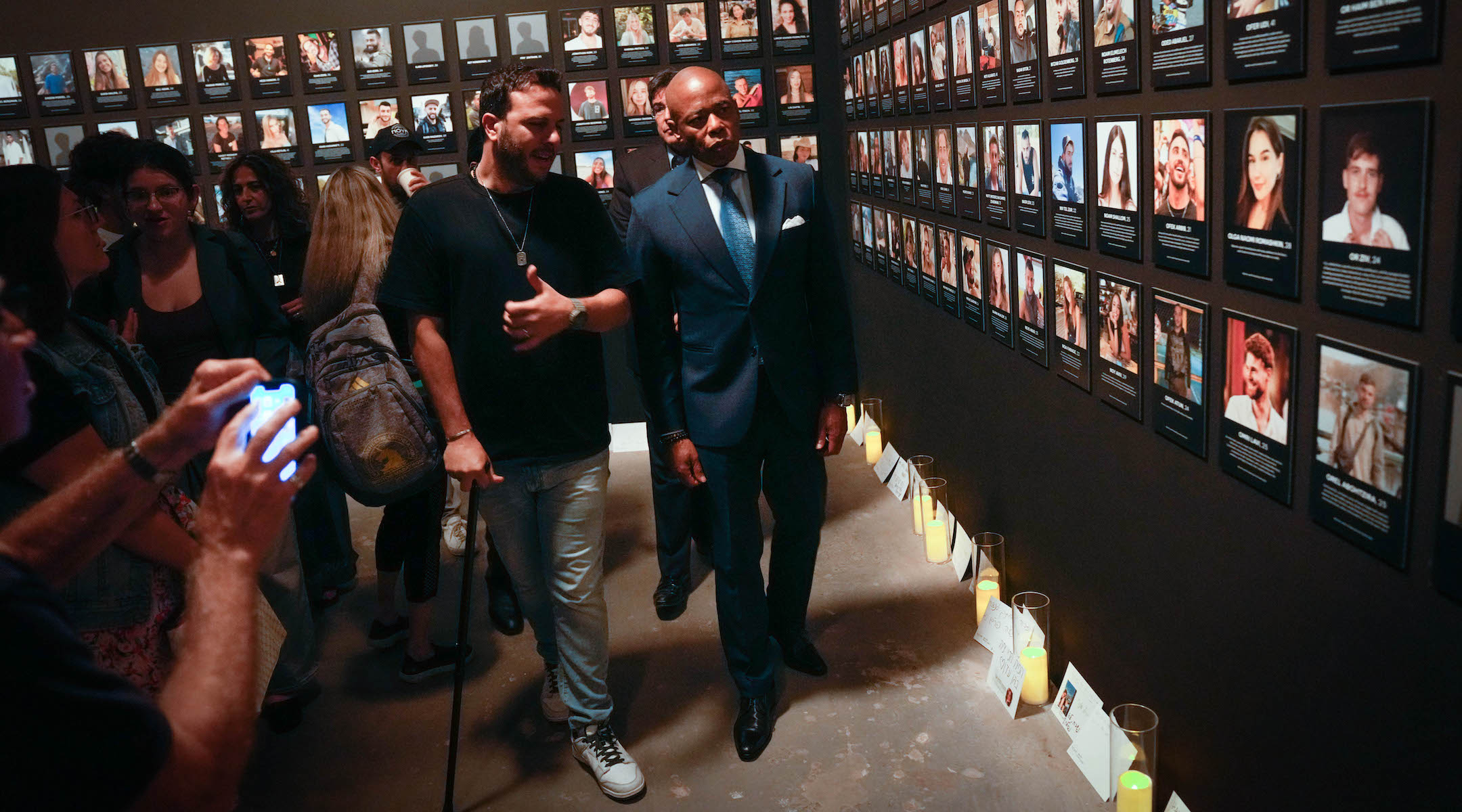When an exhibit memorializing the Oct. 7 massacre at the Nova Music Festival arrived in New York in mid-April, there was very little marketing. The producers did not disclose any information about its location until just a few days before it formally opened to the public.
But now, ahead of the exhibit’s closing on Saturday, more than 100,000 visitors have walked through the Lower Manhattan space during its two-month run, according to organizers — with a notable uptick over the past week.
According to a security guard posted outside the entrance, who wished to remain anonymous, the line has extended “for one or two street blocks pretty much constantly for the last week.” Many of those attendees arrived in response to a large Pro-Palestinian protest outside the exhibit on June 10, where protestors shot flares, carried Hamas flags and yelled chants like “Long Live the Intifada.”
On Wednesday, with many workplaces closed for Juneteenth, hundreds more showed up to see the Nova exhibit despite a major heat wave in the city. Many shared that it felt important to them as Jews to bear witness and come together as a community to view what happened on the day Hamas infiltrators killed some 370 festival-goers — and several mentioned the protest as a determining factor in their decision to visit the exhibit.
Anna, a 26-year-old from Kansas City who declined to share her last name, took advantage of the day off work to view the exhibit. After seeing the protests on social media, she booked a round-trip flight to New York City — she planned to stay for less than 24 hours and her only agenda item was to see the exhibit.
“Being a part of the Jewish culture, we all feel some connection to Israel, in a way that I felt like we have to come see it,” said Anna, who was with a friend. She described her experience viewing the exhibit as “heavy.”
“We kept thinking ‘they’re us,’” Anna said of listening and viewing the experiences of the young Israeli festival-goers. “We go to festivals with our friends, we’re in our twenties.”
The exhibit, which ran for 10 weeks in Tel Aviv at the beginning of this year, recreates the Hamas attack on the festival, through dozens of video testimonies from survivors and first responders, camping equipment and clothing discarded during the massacre, and burnt and bullet-ridden vehicles found at the site. Survivors of the festival have been available in person to give their own personal testimonies of that day. Toward the end of the exhibit, guests and survivors find themselves in a softly lit “healing room” with stations to write small notes or process the experience on couches and chairs.
“The first thing that everybody should understand is this was an international music festival, a language of the whole world,” a creator of the exhibit, Yoni Feingold, told the New York Jewish Week in April. “Our goal is to separate the idea that this international music festival was on the Israeli side of the conflict. We’re not talking about politics, we’re not talking about the conflict — this is about a music festival.”

An exterior shot of the exhibit, June 19, 2024. (Julia Gergely)
After the Within Our Lifetime-led protest outside the exhibit went viral on social media, the Nova exhibit’s producers — including music producer and philanthropist Scooter Braun — decided to extend, again, the New York City run. It had been extended previously from May 25 to June 16. The exhibit will open next in Los Angeles sometime in August, and organizers say they have plans to bring it to other cities as well.
“People understand that this thing is coming to an end, so they want to be here,” Tal Shimony, 25, a producer of the exhibit, told the New York Jewish Week.
“These people, for whatever reason, made this exhibition even more famous than it was,” Shimony — who survived the festival massacre and is now sharing her story with exhibit-goers — said of the protesters. Shimony said that in the last week there have been between 2,000 and 3,000 visitors per day, including Mayor Eric Adams and Brooklyn Rep. Hakeem Jeffries, the House Minority Leader.
“A lot of other people got angry that day, and said to themselves, if these [protesters] are going to show what they support, I would like to show support to the exhibition,” she added. Shimony described how, during the protest, security held around 500 people inside the building for about an hour, which caused her to have a “really severe panic attack” as she experienced flashbacks to hiding out for hours in a house near the festival from Hamas on Oct. 7, trying to get in contact with friends and family.
“It was horrible,” she said. “It was interesting to see the audience after those protests — there were a lot of people who originally thought it would be too hard for them to view and that didn’t want to come and decided to after the protests.”
Another attendee in the Wednesday heat was Melissa Koslowe, who drove from New Jersey to see the exhibit with her husband Jonathan. “I felt like it was just something that you need to be able to see,” she said. “My dad went to the site in Israel. We weren’t able to do that, so we figured we could support and see it here.”
Erin, a woman in her 20s who declined to share her last name, came to the exhibit while visiting New York from South Africa. She said she wanted to see the exhibit because, in her experience, there are not many opportunities to talk about being Jewish or experiencing antisemitism in her home country.
“It felt pretty important to be in New York and to be able to come down and see something like this,” she said, adding she learned about the exhibit through social media.
Some line-waiters expressed apprehension about viewing the atrocities that occurred that terrible day. One woman from Long Island said Oct. 7 felt personal to her as the child of Holocaust survivors. “I think it’s extremely important for people to see and understand what happened here,” she said.
“I’m expecting pain,” said Frady Moskowitz, who also came from Long Island to view the exhibit with her husband, Avi, who had come once before. “I’m not looking forward to it — but I think it’s important to witness.”
Another man in line, who preferred to remain anonymous, was visiting the exhibit for the second time in New York, and he also saw it in Tel Aviv. “I think everyone should see it,” he said. “It’s a great exhibit, it’s very nicely put together and very professionally done. You really feel like you’re part of it and you’re there. It’s very hard to look at this, especially if you’re Jewish — to know these innocent people got slaughtered for no reason at all.”
Shimony has been sharing her story with guests multiple times a day for the last month. “It’s not getting any easier,” she told the New York Jewish Week. “Something that is fundamental for me to continue is that I know I’m the voice of my friends in Israel that can’t speak up.
“Some days I still leave this exhibition and think ‘Is this my life? Is this a movie? What’s going on?’ What really helps me in the healing process is the support we have here,” she added. “We’ve been through a lot and we are surrounded with darkness — seeing these people who are trying to shine more light and love on this community, more than I ever had experienced in my life, is something that helps me go through the day.”
The New York Jewish Week brings you the stories behind the headlines, keeping you connected to Jewish life in New York. Help sustain the reporting you trust by donating today.





